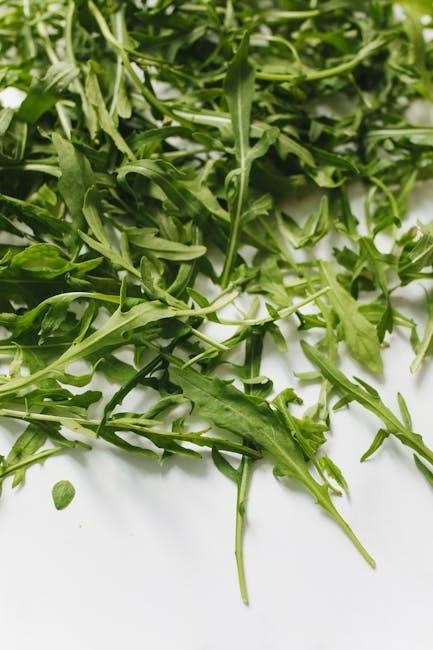A low-sulfur diet is a nutritional approach aimed at managing sulfur sensitivity by minimizing high-sulfur foods․ It’s often used short-term to alleviate symptoms like inflammation or digestive issues․
What is a Low-Sulfur Diet?
A low-sulfur diet is an eating plan that limits foods containing high amounts of sulfur‚ a naturally occurring mineral found in many foods․ It is often adopted to manage sulfur sensitivity‚ which can cause symptoms like bloating‚ inflammation‚ or digestive discomfort․ This diet focuses on reducing intake of sulfur-rich foods such as cruciferous vegetables‚ alliums (e․g․‚ garlic‚ onions)‚ and certain proteins like eggs or meat․ By minimizing sulfur intake‚ individuals aim to alleviate symptoms associated with conditions like irritable bowel syndrome (IBS) or inflammatory bowel disease (IBD)․ The diet emphasizes low-sulfur alternatives‚ such as quinoa‚ rice‚ and non-cruciferous vegetables‚ while maintaining a balanced nutrient intake․ It is typically short-term and tailored to individual needs‚ often under medical supervision․
Benefits of a Low-Sulfur Diet

Adopting a low-sulfur diet can offer several health benefits‚ particularly for individuals with sulfur sensitivity or certain medical conditions․ By reducing sulfur intake‚ many people experience a decrease in digestive discomfort‚ bloating‚ and gas․ This diet may also help alleviate symptoms of inflammatory bowel diseases like Crohn’s or ulcerative colitis․ Additionally‚ some individuals report improved skin health‚ as excessive sulfur can sometimes contribute to acne or redness․ The diet encourages the consumption of nutrient-rich‚ low-sulfur foods‚ promoting overall well-being․ It is often used as a short-term solution to identify and manage food triggers‚ helping individuals achieve a more balanced and symptom-free lifestyle․ Consulting a healthcare professional is recommended to ensure proper implementation and to address any nutritional concerns․
Foods to Avoid on a Low-Sulfur Diet
High-sulfur foods like arugula‚ asparagus‚ mustard greens‚ and cruciferous vegetables should be limited․ Processed foods containing sulfites and certain grains may also contribute to sulfur intake․
High-Sulfur Foods to Limit
A low-sulfur diet requires minimizing foods rich in sulfur compounds‚ which can exacerbate sensitivity or digestive discomfort․ These include cruciferous vegetables like broccoli‚ cauliflower‚ and Brussels sprouts‚ as well as garlic‚ onions‚ and asparagus․ Animal proteins such as red meat‚ poultry‚ and fish are also high in sulfur‚ along with eggs and dairy products like cheese․ Legumes like beans and lentils contain sulfur‚ and some grains may contribute as well․ Processed foods with sulfites‚ such as dried fruits or wine‚ should be avoided․ Even seemingly healthy options like arugula and mustard greens can be problematic due to their sulfur content․ Reducing these foods can help alleviate symptoms associated with sulfur sensitivity‚ but it’s important to maintain a balanced diet with alternative nutrient-rich options․
Processed Foods and Hidden Sulfur Sources
Processed foods often contain hidden sulfur compounds‚ making them challenging to identify․ Foods like dried fruits‚ processed meats‚ and certain snacks may include sulfites as preservatives․ Additionally‚ beverages such as wine and beer can contain sulfur due to additives․ Condiments‚ sauces‚ and even some medications‚ like epinephrine used in dental procedures‚ may harbor sulfur․ It’s crucial to read labels carefully‚ as sulfur can be disguised under various names‚ such as sodium sulfite or potassium sulfite․ Even some grains and cereals may contain sulfur-based additives․ Awareness of these sources is key to adhering to a low-sulfur diet effectively․ Always check ingredient lists and consult with a healthcare provider if unsure about hidden sulfur in medications or foods․

Low-Sulfur Food Options
Low-sulfur diets focus on fresh vegetables‚ lean proteins‚ and gluten-free grains․ Quinoa‚ fresh fruits‚ and non-cruciferous vegetables are ideal․ Boiling can reduce sulfur content in foods like broccoli and cauliflower․
Recommended Foods for a Low-Sulfur Diet
Adopting a low-sulfur diet involves focusing on foods naturally low in sulfur content․ Fresh fruits like bananas‚ berries‚ and citrus are excellent choices due to their minimal sulfur levels․ Vegetables such as cucumbers‚ bell peppers‚ and zucchini are also suitable․ Whole grains like quinoa‚ rice‚ and oats provide essential nutrients without excessive sulfur․ Lean proteins‚ including chicken‚ turkey‚ and fish like salmon‚ are recommended when prepared without high-sulfur additives․ Healthy fats like avocados‚ olive oil‚ and coconut oil are beneficial․ Herbs and spices like basil‚ ginger‚ and turmeric can add flavor without sulfur overload․ Drinking plenty of water and incorporating low-sulfur alternatives to dairy‚ such as almond milk‚ supports the diet․ Balancing these foods ensures a nutrient-rich and sulfur-conscious meal plan․
Cooking Tips to Reduce Sulfur Content
Cooking techniques can significantly reduce the sulfur content in foods․ Boiling is particularly effective‚ as it removes sulfur compounds through water․ When boiling‚ use ample water and drain thoroughly to eliminate dissolved sulfur․ Steaming is another beneficial method‚ as it breaks down sulfur-containing compounds without retaining them in the food․ Cooking vegetables like broccoli and cauliflower for longer periods can also reduce their sulfur content․ Marinating meats and fish with acidic ingredients like lemon juice may help neutralize sulfur compounds․ Additionally‚ soaking grains and legumes before cooking can further minimize sulfur levels․ By incorporating these strategies‚ individuals can enjoy a lower sulfur intake while maintaining flavor and nutritional value in their meals․

Implementing a Low-Sulfur Diet
Implementing a low-sulfur diet involves systematically removing high-sulfur foods and monitoring symptoms․ Start with an elimination phase‚ then gradually reintroduce foods to identify triggers and adjust accordingly․
Elimination Diet Approach
The elimination diet approach involves removing high-sulfur foods for 5-7 days to assess symptom improvement․ During this phase‚ focus on low-sulfur alternatives like quinoa‚ fruits‚ and low-sulfur vegetables․ If symptoms reduce‚ high-sulfur foods are reintroduced one at a time to identify triggers․ This method helps pinpoint sensitivity and tailor the diet accordingly․ Monitoring symptoms closely is crucial‚ as reactions may vary․ Consulting a healthcare provider before starting is recommended‚ especially for those with medical conditions․ This structured process ensures a personalized and effective low-sulfur plan‚ balancing nutrition while addressing specific needs․

Reintroduction of Sulfur Foods
Reintroducing sulfur foods after an elimination period is crucial for identifying triggers․ Start by adding one high-sulfur food at a time‚ monitoring symptoms for 1-4 days․ Keep a detailed food diary to track reactions․ If symptoms reappear‚ discontinue that food and wait for improvement before testing another․ This gradual process helps pinpoint specific sensitivities․ It’s essential to reintroduce foods systematically to avoid confusion․ Consider consulting a healthcare provider for guidance‚ especially if managing chronic conditions․ This step ensures a personalized diet plan‚ balancing nutrition with sensitivity needs․ Patience is key‚ as the reintroduction phase can take several weeks to complete effectively․
Health Benefits and Risks
A low-sulfur diet can reduce inflammation and alleviate digestive issues but may risk nutrient deficiencies if not properly planned․ Balance is key to maintaining overall health․

Health Benefits of Reducing Sulfur Intake
Reducing sulfur intake can offer several health benefits‚ particularly for individuals with sulfur sensitivity or conditions like inflammatory bowel disease․ Lowering sulfur consumption may help alleviate digestive discomfort‚ such as bloating or gas‚ and reduce inflammation in the body․ Some people report improved skin health‚ as sulfur-rich foods can sometimes trigger acne or rashes․ Additionally‚ minimizing sulfur may support detoxification processes‚ as excessive sulfur can strain the liver and kidneys․ For those with oxidative stress or chronic illnesses‚ a low-sulfur diet can help reduce oxidative damage․ Overall‚ balancing sulfur intake can promote a healthier digestive system and overall well-being‚ especially when tailored to individual needs and medical conditions․
Potential Risks of a Low-Sulfur Diet
While a low-sulfur diet can be beneficial for managing sulfur sensitivity‚ it may pose risks if not properly balanced․ Sulfur is essential for enzyme function‚ detoxification‚ and the synthesis of vital compounds like glutathione․ Overly restricting sulfur intake can lead to deficiencies‚ impairing these processes․ Additionally‚ eliminating too many sulfur-rich foods may result in inadequate intake of essential nutrients‚ such as vitamin B12 and molybdenum‚ which are crucial for energy production and detox pathways․ A low-sulfur diet may also strain the liver and kidneys‚ as they rely on sulfur for certain detoxification processes․ Furthermore‚ overly restrictive diets can lead to nutritional imbalances and potentially worsen health conditions․ Consulting a healthcare provider is essential to avoid these risks and ensure the diet remains safe and effective․

Special Considerations
A low-sulfur diet requires careful planning to avoid nutrient deficiencies and manage health conditions․ Consulting a healthcare provider is crucial‚ especially for those with sulfite sensitivity or medical conditions․ Dental procedures may need adjustment‚ as some anesthetics contain sulfites․ Additionally‚ molybdenum and vitamin B12 supplements may be necessary to support detoxification pathways․
Dietary Needs for Sulfur Sensitivity
For individuals with sulfur sensitivity‚ dietary adjustments are essential to manage symptoms and improve quality of life․ Focus on low-sulfur foods like quinoa‚ certain grains‚ and non-cruciferous vegetables․ Avoid high-sulfur items such as broccoli‚ garlic‚ and aged cheeses․ Cooking techniques‚ such as boiling‚ can reduce sulfur content in foods․ Supplementation with molybdenum and vitamin B12 may support detoxification pathways․ It’s crucial to consult a healthcare provider to ensure nutritional balance and address potential deficiencies․ Personalized plans may vary based on severity of sensitivity and other health conditions․ Regular monitoring of symptoms and dietary intake can help refine the approach for optimal results․
Low-Sulfur Diet and Medical Conditions
A low-sulfur diet may be beneficial for managing certain medical conditions‚ such as inflammatory bowel diseases‚ sulfur sensitivity‚ and Hashimoto’s thyroiditis․ For individuals with ulcerative colitis or other digestive disorders‚ reducing sulfur intake can alleviate symptoms like bloating and gas․ Similarly‚ those with sulfur metabolism issues may find relief by limiting high-sulfur foods․ The diet is also explored in managing conditions like SIBO (small intestinal bacterial overgrowth)‚ as sulfur can influence gut bacteria activity․ Consulting a healthcare provider is essential to tailor the diet to specific medical needs and ensure proper nutrient balance․ This approach can help mitigate symptoms and improve overall well-being for those with condition-specific requirements․
A low-sulfur diet offers benefits for managing sulfur sensitivity and conditions like IBD․ It helps reduce inflammation and alleviate symptoms‚ promoting overall well-being with careful planning and consultation․

Final Thoughts on the Low-Sulfur Diet
A low-sulfur diet can be an effective approach for managing sulfur sensitivity‚ improving digestion‚ and reducing inflammation․ By focusing on low-sulfur foods and avoiding triggers‚ individuals can achieve better overall health․ However‚ it’s important to balance nutrition and consult a healthcare provider‚ especially for those with medical conditions․ This diet is not a one-size-fits-all solution‚ and careful planning is essential to ensure adequate nutrient intake․ Patience and consistency are key‚ as symptoms may take time to improve․ For long-term success‚ gradual reintroduction of sulfur-containing foods and monitoring of tolerance are recommended․ With proper guidance‚ a low-sulfur diet can be a valuable tool for achieving wellness․

References and Further Reading
For deeper insights into the low-sulfur diet‚ consider exploring these resources:
- The Low-Iodine Quick Guide by I․ Wentz provides practical tips and recipes for managing sulfur sensitivity․
- Dr․ W․C․ Willett’s works offer evidence-based nutritional advice‚ including sulfur intake management․
- Cherry Bombe magazine features recipes and articles on dietary approaches‚ including low-sulfur options․
- ONLINE RESOURCES: Websites like [YourHealthGuide․com](https://yourhealthguide․com) and [LowSulfurDietHub․net](https://lowsulphurdiehub․net) offer detailed guides and meal plans․
These resources can help you tailor the diet to your needs and explore its benefits further․